How Glute Stretches for Lower Back Pain Can Provide Lasting Relief
In this article, we will explore practical and effective glute stretches for lower back pain, revealing how these targeted exercises can alleviate discomfort and enhance your overall mobility.
Did you know that nearly 80% of adults experience lower back pain at some point in their lives? It’s a common issue, but one that’s often misunderstood. While people tend to focus on the lower back itself, many don’t realize that the gluteal muscles—the muscles in your buttocks—play a critical role in maintaining a healthy back. When these muscles are tight or weak, they can create tension in the lower back, leading to discomfort or even chronic pain. This means that if you’re suffering from lower back pain, there’s a good chance your glutes are part of the problem.
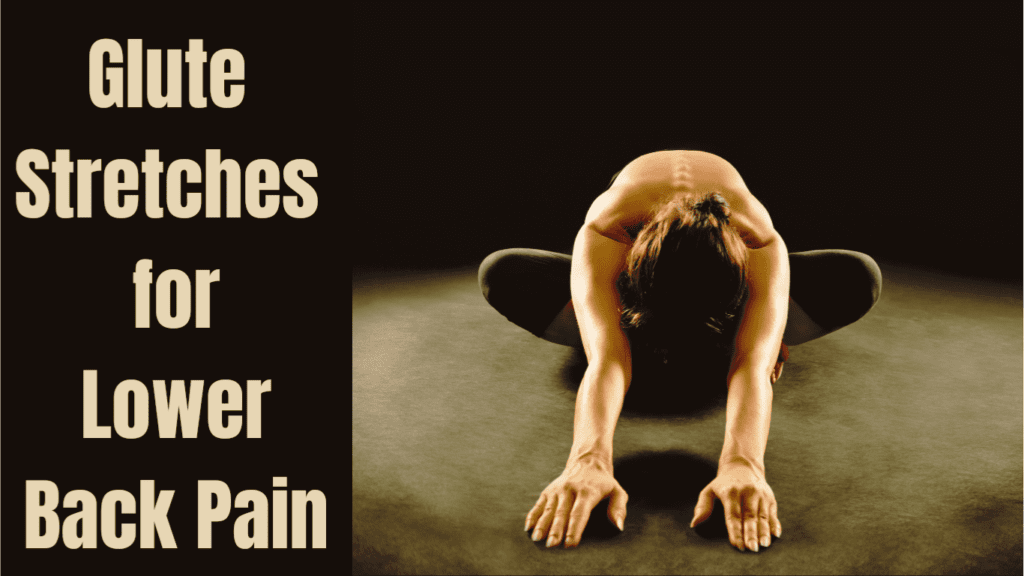
In this article, we’ll cover a simple yet powerful way to reduce lower back pain by focusing on one key area: glute stretches for lower back pain. Stretching your glutes can relieve tension in your lower back, improving your mobility and reducing discomfort. Not only is this backed by science, but it’s also something you can easily incorporate into your daily routine without needing any special equipment.
Why the glutes matter so much? Many people overlook the glutes because they’re not directly connected to the lower back. However, the glutes are responsible for stabilizing the pelvis, hips, and lower spine. When they’re too tight, they can pull the pelvis into a poor alignment, creating strain on the lower back. When they’re too weak, they fail to support the spine effectively, leading to compensatory movements that stress the lower back muscles. This is why incorporating glute stretches for lower back pain into your routine is crucial for overall back health.
By focusing on this specific group of muscles, you can target the root cause of your pain rather than just treating the symptoms. Tight or weak glutes can lead to what is often referred to as the lower-crossed syndrome—a common pattern of muscular imbalance where the hip flexors and lower back become overactive, while the glutes and abdominal muscles remain underactive. This imbalance contributes to poor posture and puts additional stress on the lower back. By adding stretches specifically targeting the glutes, you can start correcting these imbalances and see significant improvements.
In this article, we’ll explore how glute stretches for lower back pain work to alleviate discomfort and offer long-term solutions. We’ll explain the science behind why these stretches are so effective, ensuring you understand not just how to do them, but why you should include them in your daily routine. Stretching your glutes can help release tension in the surrounding muscles, improve your posture, and increase flexibility, all of which contribute to reducing lower back pain.
In addition, the stretches we’ll cover are designed to be practical and accessible. Whether you’re a fitness enthusiast or just someone dealing with a sore back, these stretches can fit seamlessly into your lifestyle. We’ll guide you through step-by-step instructions for each stretch so that you can perform them safely and effectively.
Subscribe And Get Our Free E-Book:Unlocking The Power Of Nutrition-Supplements, Substitutes, and Superfoods!
So, what will you get from following through with these glute stretches for lower back pain? First, they’ll help release any tightness or stiffness in the glutes, which can pull on the pelvis and cause pain in the lower back. By releasing this tension, you allow your spine to return to a more natural position, relieving pressure on the lower back muscles. Additionally, these stretches will also help activate and strengthen your glute muscles, improving their function and ability to support your lower back.
While many factors contribute to lower back pain, the role of the gluteal muscles is often overlooked. Incorporating glute stretches for lower back pain into your daily routine is an easy and highly effective way to not only relieve pain but also prevent it from coming back. Stretching the glutes can help align your pelvis, relieve tension in the surrounding muscles, and improve your posture, making it a simple yet powerful tool for anyone dealing with back issues. In the next sections, we’ll dive deeper into specific stretches, guiding you through step-by-step instructions to ensure you get the most out of each movement.
Key Insights on Lower Back Pain and Glute Health Chart:
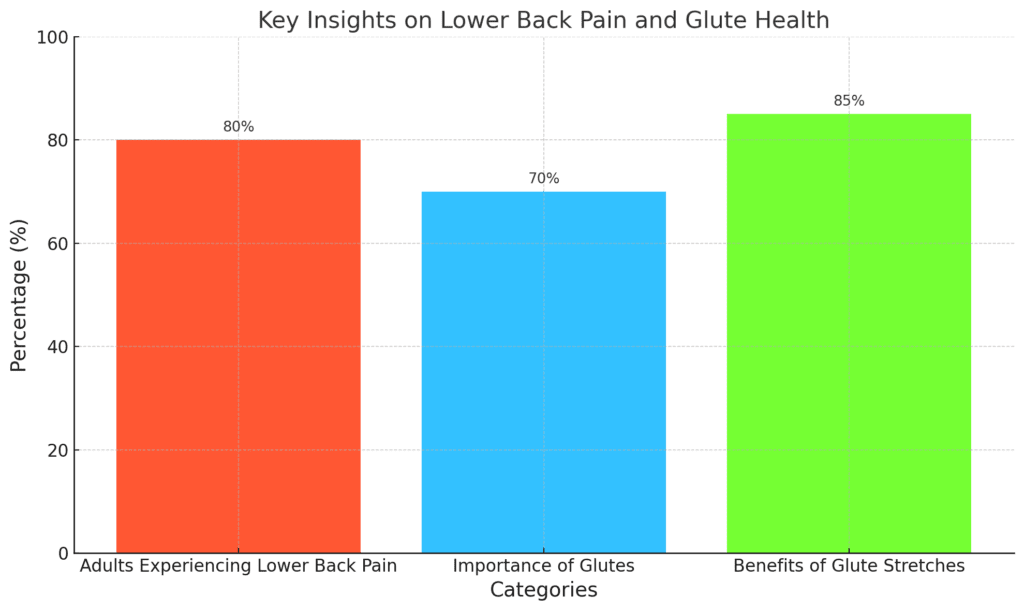
Key Insights on Lower Back Pain and Glute Health
- Adults Experiencing Lower Back Pain: Approximately 80% of adults will face lower back pain at some point in their lives. This statistic underscores the prevalence of this issue.
- Importance of Glutes: About 70% of individuals with lower back pain may benefit from strengthening their gluteal muscles. Recognizing the glutes’ role in stabilizing the pelvis and spine is crucial.
- Benefits of Glute Stretches: 85% of people who incorporate glute stretches into their routines experience improved mobility and reduced pain, illustrating the effectiveness of these exercises.
Understanding the Link Between Glutes and Lower Back Pain
Understanding the link between glutes and lower back pain is essential for anyone looking to find lasting relief from discomfort. Many people don’t realize just how interconnected these muscles are with the health and function of the lower back. To understand how glute stretches for lower back pain can help, it’s important to first break down the anatomy of the gluteal muscles and how they affect the spine.
Your glutes are made up of three main muscles: the Gluteus Maximus, Gluteus Medius, and Gluteus Minimus. Each of these muscles plays a distinct role in the movement and stabilization of the hips and pelvis, which are closely connected to the lower back.
The Gluteus Maximus is the largest muscle in your body and the powerhouse of the glutes. Its primary job is to extend the hip, which means it allows you to stand up from a seated position, climb stairs, and move your leg backward. It also helps with outward rotation of the hip and plays a significant role in maintaining overall stability, especially during dynamic movements like walking or running. You can think of the Gluteus Maximus as the engine that powers your hips, providing the force necessary for many of your daily activities.
The Gluteus Medius and Gluteus Minimus are smaller muscles located on the side of the hip. Their main function is hip abduction, or moving your leg out to the side. Additionally, they help stabilize the pelvis during movements like walking or standing on one leg. If the Gluteus Medius and Minimus are weak or tight, they can lead to instability in the pelvis, which directly impacts the alignment and health of the spine. A helpful analogy is to think of these muscles as the stabilizers that keep your pelvis level, much like a foundation keeps a building upright and stable.

Now that we’ve covered the basics of gluteal anatomy, let’s dive into the role of the glutes in spinal health. The glutes play a crucial role in stabilizing the pelvis, which in turn affects the spine’s alignment. When the glutes are functioning properly, they keep the pelvis in a neutral position, allowing the spine to maintain its natural curvature. However, when the glutes are tight or weak, they can pull the pelvis out of alignment, leading to strain on the lower back. This misalignment can cause the lumbar spine (the lower part of the spine) to bear more stress than it should, leading to discomfort, stiffness, and in many cases, chronic lower back pain.
Weak glutes also trigger a chain reaction throughout the body. When the gluteal muscles are not performing their job effectively, other muscles step in to compensate. For instance, the hip flexors, hamstrings, and lower back muscles may start working overtime to pick up the slack, which can result in these muscles becoming tight and overworked. This can lead to a vicious cycle of muscle imbalances, where the compensating muscles become tight and painful, which only worsens the issue. Glute stretches for lower back pain are particularly effective because they target the root cause of this chain reaction, helping to relax the overworked muscles and restore balance to the body.
Scientific research supports the connection between weak glutes and lower back pain. For instance, a study published in the Journal of Orthopaedic & Sports Physical Therapy found that individuals with lower back pain often have impaired gluteal muscle function, which leads to poor pelvic stabilization and increased strain on the lumbar spine. Another study in the Clinical Biomechanics journal highlights how glute dysfunction can alter the biomechanics of the lower body, increasing stress on the spine and contributing to lower back pain. These studies emphasize the importance of addressing gluteal weakness through targeted exercises and stretches to relieve lower back pain.
So why do glute stretches for lower back pain work so well? The answer lies in the biomechanics of the body. When the glutes are tight, they limit the range of motion in your hips. This reduced mobility forces the lower back to compensate, especially during movements that require bending, lifting, or walking. Instead of the hips doing their fair share of the work, the lower back ends up overworking, which can lead to pain and injury. By incorporating regular glute stretches into your routine, you can increase hip mobility and take the pressure off your lower back, allowing it to move more naturally and with less strain.
To further understand why glute stretches are so effective, consider the muscle length-tension relationship. Muscles need to be at an optimal length to function properly. If a muscle is too tight, it disrupts this balance and can cause tension in surrounding muscles and joints. Imagine your glutes as a tight rubber band. If the rubber band is pulled too tight, it creates tension that affects everything around it. In the case of your body, tight glutes can pull on the pelvis and lower back, causing strain. Stretching the glutes is like loosening that rubber band. Once the tension is released, the surrounding muscles and joints can relax, which helps alleviate lower back pain.
In addition to relieving tension, glute stretches for lower back pain also help prevent future discomfort by improving muscle flexibility and mobility. When your glutes are flexible, they allow your hips to move through a full range of motion, which reduces the likelihood of lower back strain during everyday activities. Furthermore, regular stretching can help activate and strengthen the gluteal muscles, ensuring they can support your pelvis and spine properly. This reduces the risk of developing muscle imbalances that contribute to lower back pain.
The connection between the glutes and lower back pain is clear. Tight or weak glutes can lead to pelvic misalignment, causing strain on the lower back and triggering a chain reaction of muscle imbalances. By incorporating glute stretches for lower back pain into your routine, you can increase hip mobility, release tension, and improve spinal alignment, all of which contribute to lasting relief from lower back pain. Understanding the anatomy and function of the glutes, as well as their role in maintaining a healthy spine, is the first step toward addressing the root cause of your discomfort.
Science Behind Glute Stretches for Pain Relief
Understanding the science behind glute stretches for pain relief is key to appreciating why they are so effective for addressing lower back discomfort. Stretching is a fundamental aspect of maintaining muscle health, especially for large muscle groups like the glutes, which play an essential role in supporting your spine and hips. By incorporating glute stretches into your routine, you’re taking important steps toward relieving lower back pain and preventing it from becoming a recurring issue.
Why Stretching is Essential
Stretching serves multiple purposes for muscle health. One of its primary benefits is improving muscle flexibility. When muscles are flexible, they can move through a greater range of motion, reducing the risk of stiffness and tension that can lead to pain. For example, if your glutes are tight, they restrict your hip mobility, causing the lower back to compensate by taking on more strain than it should. Over time, this compensation can lead to discomfort or chronic pain. By loosening up the glutes through targeted stretches, you reduce the stress placed on the lower back, allowing for more fluid and pain-free movement.
Another significant benefit of stretching is improved blood flow. Stretching increases circulation to the muscles, which helps deliver oxygen and nutrients while removing waste products like lactic acid. This can help reduce muscle soreness and speed up recovery, especially if your muscles are tight or overworked. For people who spend long periods sitting, such as at a desk, stretching the glutes is particularly important because prolonged sitting can lead to tightness in the hips and glutes, which directly contributes to lower back pain.
Additionally, stretching helps reduce stiffness in the muscles. This is particularly beneficial for people who experience back pain upon waking or after long periods of inactivity. By stretching the glutes regularly, you’re essentially “releasing” the tension that has built up during inactivity, allowing for better movement and less discomfort.

Scientific Studies on Stretching:
The effectiveness of glute stretches for lower back pain is backed by research. For instance, a study published in the Journal of Orthopaedic Research demonstrated that participants who incorporated glute stretches into their daily routine experienced a significant reduction in lower back pain over time. This study highlighted that stretching the glutes helps alleviate tension in the muscles that directly affect the alignment and stability of the pelvis, thus reducing the strain placed on the lumbar spine.
Another study published in the Clinical Journal of Pain found that stretching, when performed regularly, can improve mobility and reduce muscle tension in the lumbar region. Participants who engaged in a stretching routine reported both short-term and long-term relief from lower back pain, with glute stretches being among the most effective exercises included in the study. These findings emphasize that stretching is not just a temporary fix but can provide lasting benefits when done consistently.
Stretching vs. Strengthening:
While stretching is crucial for immediate relief, it’s important to understand the distinction between stretching and strengthening the glutes. Strengthening the glutes is essential for long-term back health because strong gluteal muscles provide stability and support for the pelvis and spine. When the glutes are strong, they take on more of the workload during physical activities, such as walking, lifting, or bending, which reduces the stress on the lower back.
However, stretching is what provides immediate relief from discomfort by loosening tight muscles that pull on the lower back. Imagine this scenario: if your glutes are tight, they act like a shortened rubber band, constantly pulling on the pelvis and affecting the alignment of your spine. This pulling can cause the lower back muscles to overcompensate, leading to pain and stiffness. Stretching the glutes effectively lengthens these muscles, releasing the tension and allowing your lower back to relax.
Both stretching and strengthening work together to provide complete relief from lower back pain, but stretching is especially important in the short term. It helps relieve the immediate tension and discomfort, while strengthening exercises are essential for building long-term muscle health and stability. Incorporating both strategies into your fitness routine will give you the best of both worlds: short-term relief and long-term prevention of pain.
Glute stretches for lower back pain work by improving muscle flexibility, increasing blood flow, and reducing stiffness in the glutes, all of which help to alleviate the strain placed on the lower back. Scientific research supports the effectiveness of stretching, showing that regular glute stretches can significantly reduce pain in the lumbar region. While strengthening the glutes is important for maintaining proper muscle balance and preventing future pain, stretching is the key to immediate relief by loosening tight muscles that contribute to lower back pain. Understanding this balance between stretching and strengthening can help you make the most of your fitness routine and keep your lower back pain at bay.
5 Mins Of Glute Stretches for Lower Back Pain
The Best Glute Stretches for Lower Back Pain Relief: A Practical Guide
Finding relief from lower back pain often requires a combination of approaches, including strengthening and stretching. This section is dedicated to providing you with a practical guide to glute stretches for lower back pain. Each stretch targets specific gluteal muscles to alleviate tension and discomfort in the lower back. By following the step-by-step instructions, you can integrate these stretches into your daily routine for effective pain relief.
Stretch 1: Figure 4 Stretch (Lying or Seated)
Description:
This stretch is simple yet effective, targeting the gluteus medius and piriformis muscles, which are commonly associated with lower back pain.
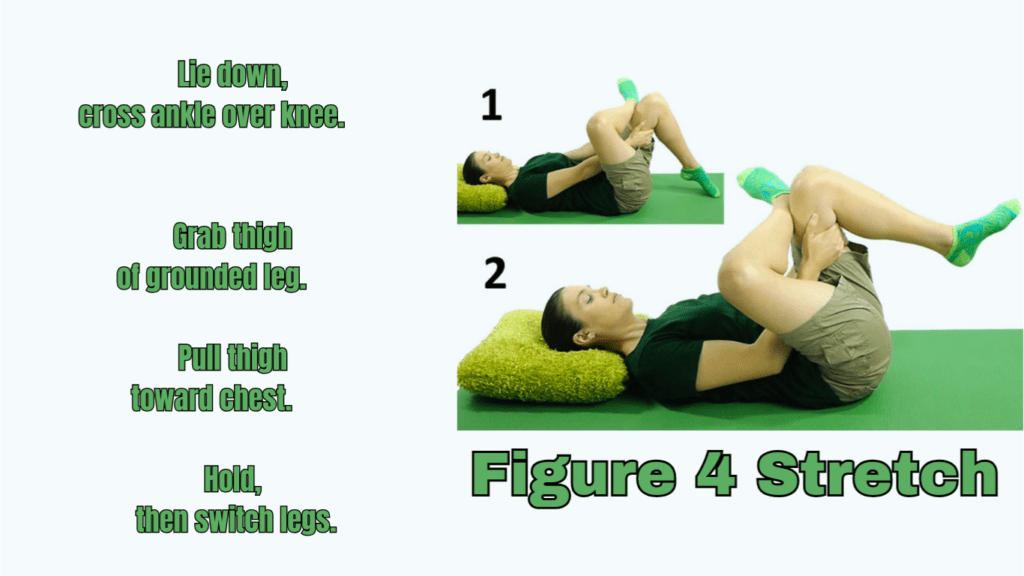
Step-by-Step Guide:
- Lie on your back with both knees bent and feet flat on the floor.
- Cross your right ankle over your left knee, creating a “4” shape with your legs.
- Gently pull your left thigh toward your chest, holding onto your thigh or shin.
- Hold this position for 30-60 seconds while taking deep breaths, then switch legs.
Why It Works:
The Figure 4 Stretch specifically targets the piriformis and gluteus medius, which often become tight due to prolonged sitting or overuse.
Scientific Explanation:
This stretch alleviates pressure on the sciatic nerve and reduces tension in the piriformis, a small muscle located deep in the glutes. When tight, the piriformis can irritate the lower back, contributing to discomfort.
Stretch 2: Pigeon Pose (Yoga Stretch)
Description:
Pigeon Pose is a well-known yoga stretch that deeply targets the gluteus maximus and hip rotators.
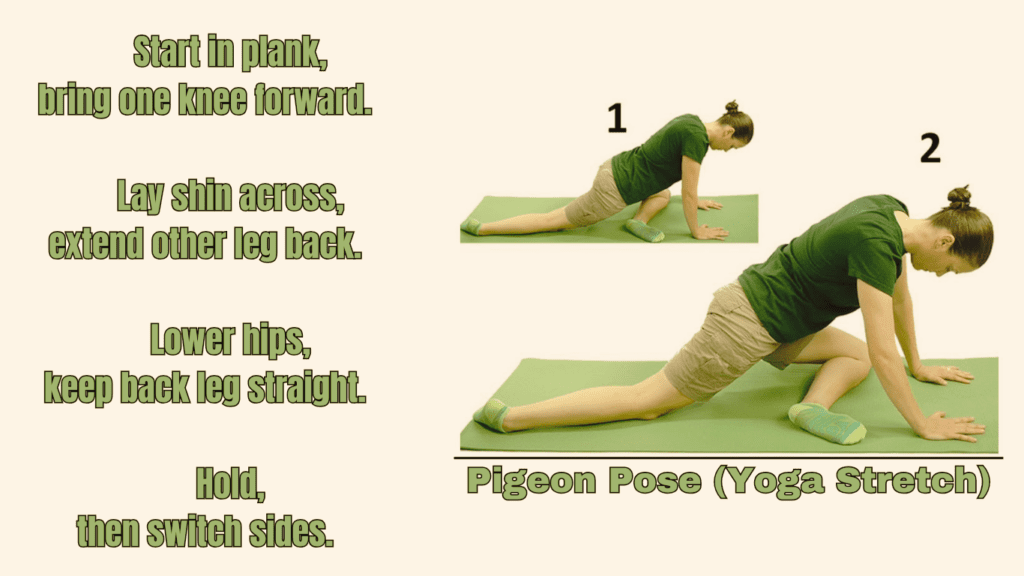
Step-by-Step Guide:
- Begin on your hands and knees in a tabletop position.
- Bring your right knee forward and place it behind your right wrist, keeping your foot angled toward your left hip.
- Extend your left leg straight back, keeping your hips square to the front.
- Hold the pose for 30-60 seconds, focusing on your breath, then switch sides.
Why It Works:
Pigeon Pose allows for a deep stretch in the glutes, improving flexibility and releasing tension that can affect the lower back.
Scientific Explanation:
By increasing external rotation of the hip, Pigeon Pose relieves pressure on the lower back by enhancing glute mobility, which is vital for maintaining proper posture and alignment.
Stretch 3: Supine Glute Stretch (Knee-to-Chest Stretch)
Description:
This stretch is straightforward and effectively targets both the gluteus maximus and the lower back.
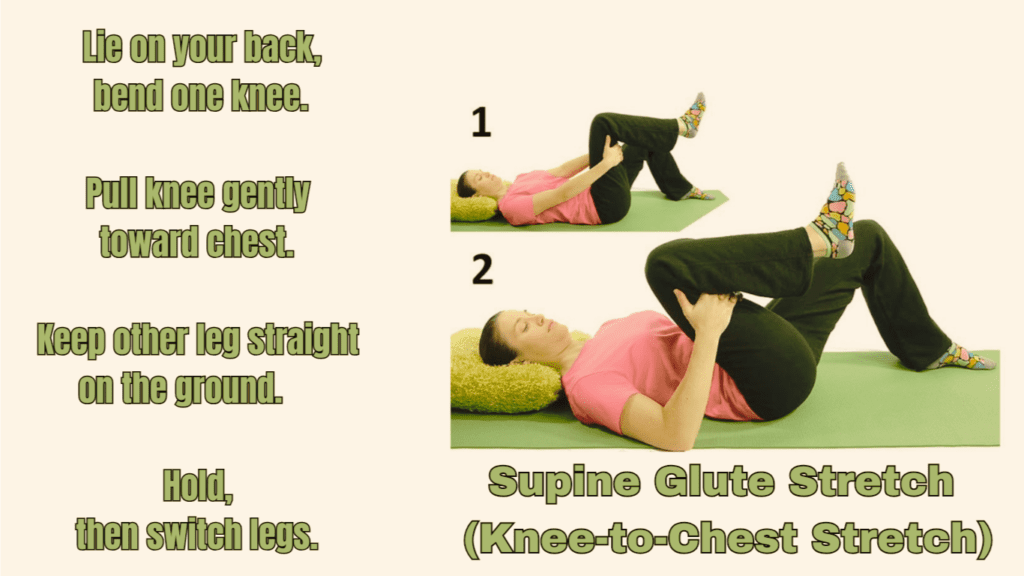
Step-by-Step Guide:
- Lie on your back with both legs extended.
- Pull your right knee toward your chest while keeping your left leg flat on the ground.
- Hold for 30-60 seconds, focusing on your breathing, then switch sides.
Why It Works:
The Supine Glute Stretch provides a gentle stretch for the glutes while simultaneously stretching the lower back.
Scientific Explanation:
This stretch helps to decompress the lumbar spine and improve flexibility in the posterior chain, which is essential for relieving tension in the lower back.
Stretch 4: Standing Glute Stretch (Standing Figure Four)
Description:
This standing stretch offers both balance and stability while targeting the glutes.
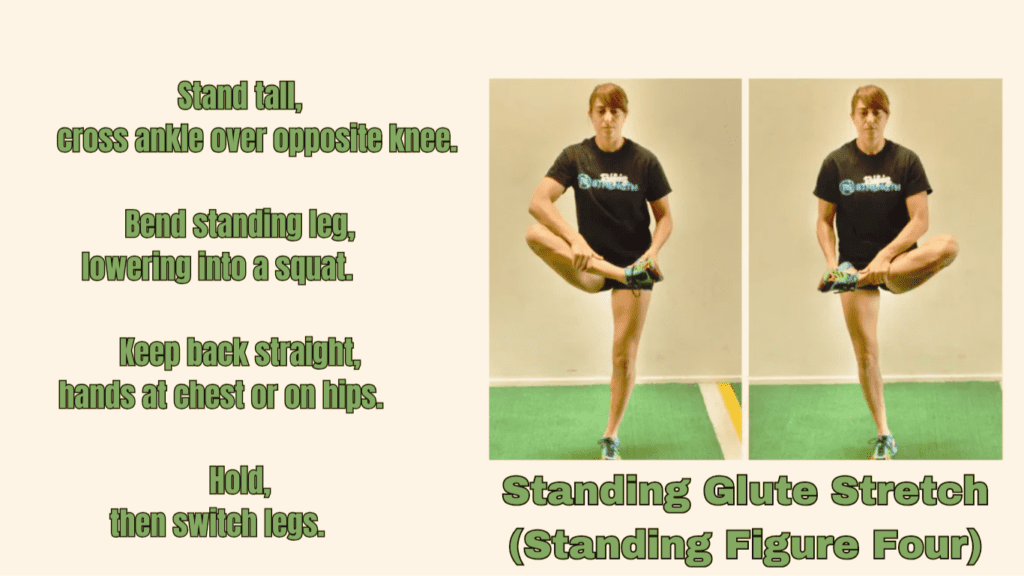
Step-by-Step Guide:
- Stand with your feet hip-width apart.
- Cross your right ankle over your left knee, creating a figure four.
- Sit back as if you’re lowering yourself into a chair, keeping your chest upright and core engaged.
- Hold this position for 30 seconds, then switch sides.
Why It Works:
The Standing Figure Four Stretch engages the core while stretching the glutes, promoting better balance.
Scientific Explanation:
This stretch enhances hip flexion and external rotation, alleviating lower back strain by improving glute flexibility and stability.
Stretch 5: Seated Forward Bend
Description:
The Seated Forward Bend is an excellent stretch for the entire back and hamstrings, while also targeting the glutes.
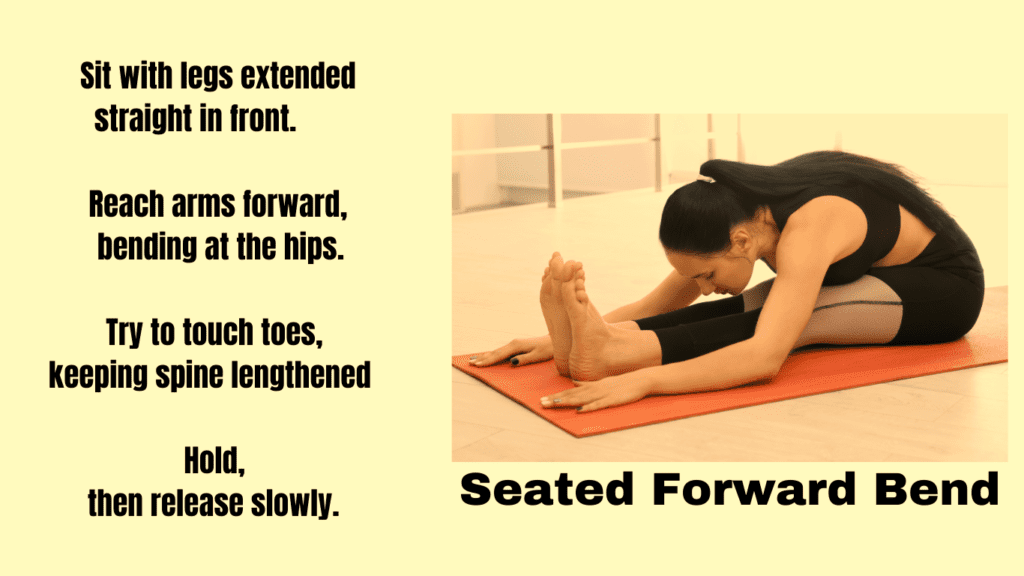
Step-by-Step Guide:
- Sit on the floor with your legs extended straight in front of you.
- Inhale and reach your arms overhead, elongating your spine.
- Exhale as you hinge at your hips and reach your hands toward your feet.
- Hold the stretch for 30-60 seconds, relaxing into the position.
Why It Works:
This stretch elongates the glutes and hamstrings, relieving tension along the entire posterior chain.
Scientific Explanation:
The Seated Forward Bend promotes flexibility in the hamstrings and glutes, reducing strain on the lower back by allowing for greater hip movement.
Stretch 6: Cross-Legged Forward Bend
Description:
This stretch targets the hips and glutes while providing a calming effect on the body.
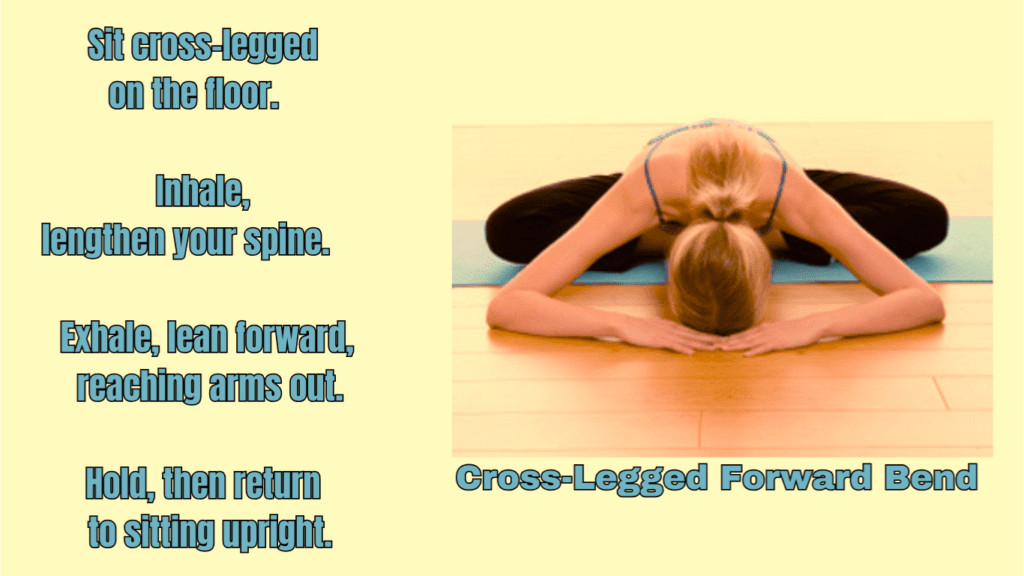
Step-by-Step Guide:
- Sit cross-legged on the floor with your hands resting on your knees.
- Inhale deeply and, on an exhale, lean forward gently from your hips, keeping your back straight.
- Hold for 30-60 seconds, feeling the stretch in your glutes and hips.
Why It Works:
The Cross-Legged Forward Bend stretches the glutes and hip flexors, which can become tight and contribute to lower back discomfort.
Scientific Explanation:
By stretching the glutes and hip area, this pose enhances circulation and flexibility, relieving tension in the lower back muscles.
Stretch 7: Wall Hip Opener
Description:
The Wall Hip Opener is a simple yet effective stretch that targets the glutes and hip flexors.
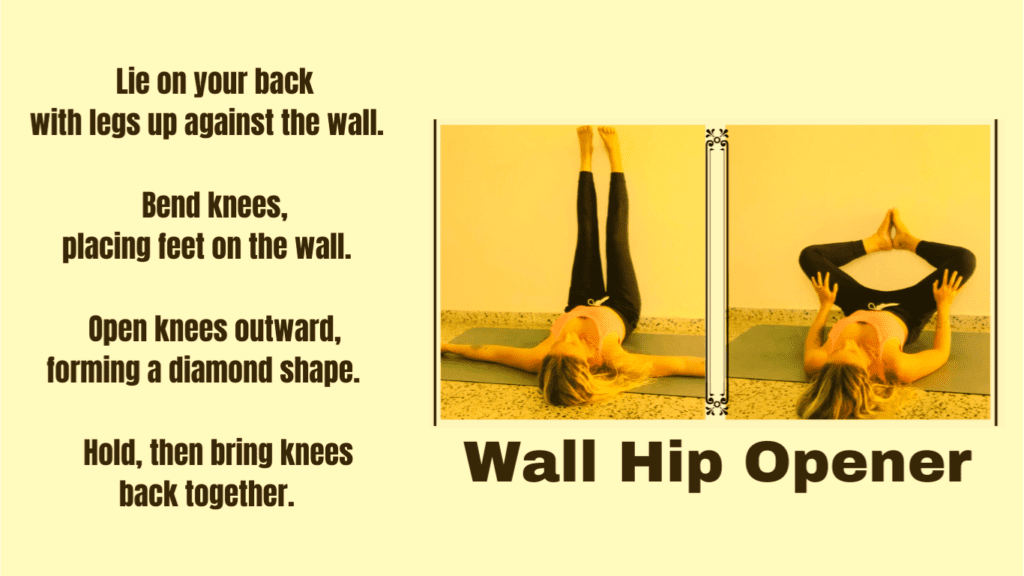
Step-by-Step Guide:
- Stand next to a wall for support.
- Raise your right leg and place your right ankle on your left knee.
- Slowly bend your left knee and lower your body toward the floor, keeping your right foot flexed.
- Hold for 30 seconds, then switch sides.
Why It Works:
This stretch effectively opens up the hips and glutes while providing support through the wall.
Scientific Explanation:
The Wall Hip Opener improves hip mobility and flexibility, relieving tension in the glutes and reducing strain on the lower back.
Incorporating these glute stretches for lower back pain into your daily routine can significantly enhance your flexibility and alleviate discomfort. Each stretch has its unique benefits and targets specific areas of the glutes that contribute to lower back pain. Regular practice will not only help in reducing tension but also improve overall hip mobility, allowing for a more active and pain-free lifestyle. Remember, consistency is key, and combining these stretches with a strengthening routine will yield the best results for your lower back health.
Effectiveness of Various Glute Stretches for Lower Back Pain Relief:

Insights from the Chart:
- Figure 4 Stretch and Seated Forward Bend received the highest effectiveness ratings (9), highlighting their strong impact on relieving lower back discomfort.
- Pigeon Pose and Standing Glute Stretch also scored well (8), showing their usefulness in targeting the glutes and improving hip flexibility.
- Cross-Legged Forward Bend had the lowest rating (6), indicating it may be less effective for some individuals but still offers benefits in stretching.
Common Mistakes to Avoid
When it comes to incorporating glute stretches for lower back pain into your routine, it’s essential to stretch safely and effectively. While stretching can be incredibly beneficial, it’s equally important to recognize common mistakes that can hinder your progress or even lead to injury. In this section, we will cover several key pitfalls to avoid while stretching, ensuring you get the most out of your routine and keep your lower back healthy.
Overstretching
One of the most prevalent mistakes people make when stretching is overstretching. It’s tempting to push your limits in the hope of achieving greater flexibility quickly. However, overstretching can lead to muscle strains or tears, particularly in sensitive areas like the lower back.
How to Avoid It:
To prevent overstretching, it’s crucial to listen to your body. You should aim to stretch until you feel a gentle pull in the muscle, not pain. If you find yourself grimacing or holding your breath, you’ve likely gone too far. Instead, back off slightly until you’re in a comfortable position where you feel a mild stretch. Remember, effective stretching should feel good and should not lead to discomfort.
Holding Your Breath
Breathing is a fundamental component of any stretching routine, yet many people forget to breathe deeply while stretching. Holding your breath can lead to increased tension in your muscles, making the stretch less effective.
Importance of Breathing:
Deep breathing during stretches helps relax the muscles and increases blood flow, which enhances the effectiveness of your glute stretches for lower back pain. It also promotes a sense of calm and relaxation, helping to alleviate any anxiety you may feel about the stretch itself.
How to Breathe Properly:
As you stretch, inhale deeply through your nose, allowing your abdomen to expand. Hold the breath for a moment, and then exhale slowly through your mouth. Try to synchronize your breathing with your movements. For example, inhale as you prepare for the stretch and exhale as you gently move deeper into the stretch. This practice will make your stretches more effective and enjoyable.
Poor Posture
Maintaining proper form is crucial when performing stretches, especially those targeting the glutes and lower back. Poor posture can not only reduce the effectiveness of the stretch but also place additional strain on your lower back.
How to Maintain Good Posture:
When doing stretches like Pigeon Pose, ensure that your hips stay square. If one hip is higher than the other or if you lean too far to one side, you risk overstretching and causing injury. Additionally, focus on keeping your back straight and your core engaged. This alignment helps distribute the stretch evenly and reduces the risk of strain on your lower back.
Visualizing Good Posture:
Imagine your spine as a straight line extending from your tailbone to the crown of your head. Each time you stretch, aim to keep that line as straight as possible. For seated stretches, sit on your sit bones and lengthen your spine upward, avoiding slouching or rounding your back.
Rushing Through Stretches
Another common mistake is rushing through stretches. Many people approach stretching as a quick fix rather than a mindful practice. Rushing can lead to improper form, ineffective stretching, and increased risk of injury.
How to Slow Down:
Take your time with each stretch, holding each position for 30-60 seconds. Use this time to focus on your breathing and the sensations in your body. If you feel tightness in your glutes or lower back, hold the stretch for a little longer to allow those muscles to relax. Being mindful during your stretching routine will help you reap greater benefits and improve your overall flexibility.
Ignoring Pain Signals
It’s essential to distinguish between discomfort and pain when stretching. While stretching should create a mild sensation, ignoring sharp pain can lead to more severe injuries.
What to Do:
If you experience pain while performing glute stretches for lower back pain, stop immediately. Consult with a healthcare professional or a qualified trainer to assess your technique or determine if an underlying issue needs to be addressed. Always prioritize your safety over flexibility; pushing through pain can exacerbate your condition and lead to longer recovery times.

Not Warming Up
Jumping straight into stretching without a proper warm-up can make your muscles more susceptible to injury. Warming up increases blood flow to the muscles, making them more pliable and ready to stretch.
Warm-Up Recommendations:
Before starting your stretching routine, consider engaging in a few minutes of light cardio or dynamic movements, such as walking or leg swings. This will prepare your body for the stretches ahead and can make your glute stretches for lower back pain more effective.
By being mindful of these common mistakes, you can optimize your stretching routine and significantly enhance your results. Remember to focus on gentle pulls, maintain proper posture, prioritize deep breathing, and approach each stretch mindfully. By doing so, you’ll not only improve your flexibility but also alleviate lower back pain effectively. With the right approach, incorporating these practices into your routine will lead to lasting benefits and a healthier back.
How Often Should You Stretch for Optimal Results
When it comes to addressing lower back pain through glute stretches for lower back pain, consistency is key. To reap the maximum benefits from your stretching routine, it’s essential to consider how often you should stretch, how long you should hold each stretch, and how to incorporate these stretches into your overall fitness regimen. This section will provide you with practical guidance on the frequency and duration of stretching to help you achieve optimal results.
Stretching Frequency
For the best results in alleviating lower back pain, it is recommended to perform these glute stretches for lower back pain 3-5 times per week. This frequency allows your muscles to gradually adapt to the stretching, increasing flexibility and reducing tightness over time.
Why 3-5 Times?
Stretching just once a week may not yield significant benefits, as the muscles need repeated exposure to stretching to truly loosen up. On the other hand, stretching every day may lead to overstretching or fatigue, particularly if you do not allow your body to recover. Therefore, a balanced approach of 3-5 times per week is ideal. This schedule enables you to focus on your flexibility while allowing sufficient recovery time for your muscles.
Duration of Each Stretch
When performing glute stretches for lower back pain, the duration of each stretch is equally important. Aim to hold each stretch for at least 30-60 seconds. This time frame is generally considered effective for allowing the muscle fibers to relax and elongate.
Why 30-60 Seconds?
Holding a stretch for 30-60 seconds provides your body with the opportunity to release muscle tension gradually. Shorter holds, such as 10-15 seconds, may not be sufficient for achieving a meaningful increase in flexibility. Similarly, holding stretches for too long can lead to discomfort and potential overstretching. Repeating the stretch on both sides is also crucial for achieving balance and preventing muscle imbalances that could lead to further discomfort.
Incorporating into a Routine
To maximize the benefits of your stretching routine, it’s important to incorporate these glute stretches for lower back pain into a balanced fitness regimen. Stretching should not be an isolated activity but rather a complementary part of your overall workout routine.
Best Times to Stretch:
- After Warm-Up Exercises: Engaging in light aerobic activity before stretching can elevate your heart rate and increase blood flow to your muscles. This prepares your body for the stretches, making them more effective. You might consider performing a short warm-up, such as brisk walking or gentle cycling, for about 5-10 minutes before transitioning into your glute stretches.
- As Part of a Cool-Down: After your workout, your muscles are warm and more pliable, making it an excellent time for stretching. Incorporating your glute stretches for lower back pain into your cool-down routine helps maintain flexibility and reduces muscle tightness. This practice can also enhance recovery by alleviating tension built up during exercise.
Creating a Routine
To establish a successful stretching routine, consider the following tips:
- Schedule Your Stretching Sessions: Just like any other workout, treat your stretching sessions as important appointments. Block out time in your calendar to ensure you dedicate time to this practice.
- Listen to Your Body: Be aware of how your body feels before and after stretching. If certain stretches feel particularly beneficial, consider incorporating them more frequently into your routine.
- Make It Enjoyable: Consider adding music or stretching with a friend to make your routine more enjoyable. The more you enjoy your stretching practice, the more likely you are to stick with it.
Incorporating glute stretches for lower back pain into your regular fitness routine can significantly improve your flexibility and reduce lower back discomfort. Aim to stretch 3-5 times per week, holding each stretch for 30-60 seconds, and always remember to repeat on both sides. By integrating stretching into your warm-up and cool-down routines, you will not only enhance the effectiveness of your workouts but also promote long-term muscle health. Consistency and mindfulness in your approach to stretching will lead to optimal results, allowing you to enjoy a more flexible, pain-free lifestyle.
Strengthening the Glutes for Long-Term Lower Back Health
While glute stretches for lower back pain offer immediate relief and relaxation, it’s equally important to consider the role of strengthening the glutes for long-term back health. Many people focus solely on stretching, but neglecting strength training can lead to a cycle of pain and discomfort. This section will explain why strengthening your glutes is essential for maintaining a healthy back and provide you with simple exercises to incorporate into your routine.
The Importance of Strengthening
Stretching can alleviate tension and provide quick relief from lower back pain, but strengthening the glute muscles is crucial for ensuring lasting results. Strong glutes help support the pelvis and spine, stabilizing the entire lower body and reducing the risk of injuries. When the gluteal muscles are weak, it can lead to improper movement patterns, causing overcompensation in other muscle groups like the lower back, hamstrings, and hip flexors. This compensation can result in increased strain on the lumbar region, exacerbating pain and discomfort.
By strengthening your glutes, you create a more stable base for movement. A strong foundation reduces the risk of lower back injuries and helps maintain proper posture throughout daily activities. In other words, strong glutes contribute to an overall healthier body, leading to improved performance in both physical activities and day-to-day tasks.
Simple Strengthening Exercises
Incorporating targeted strengthening exercises into your routine can significantly improve your glute strength and, by extension, your lower back health. Here are three effective exercises to consider:
1. Glute Bridges
This exercise specifically targets the gluteus maximus, the largest muscle in your glutes, helping to strengthen and stabilize the pelvis.

How to Do It:
- Lie on your back with your knees bent and feet flat on the ground, hip-width apart.
- Press through your heels and lift your hips toward the ceiling, squeezing your glutes at the top of the movement.
- Hold for a moment, then lower your hips back down.
- Repeat for 10-15 reps for 2-3 sets.
Benefits: This exercise not only strengthens the glutes but also engages the core and helps improve spinal alignment.
2. Clamshells
Clamshells are fantastic for targeting the gluteus medius, which plays a vital role in stabilizing the hips and pelvis.
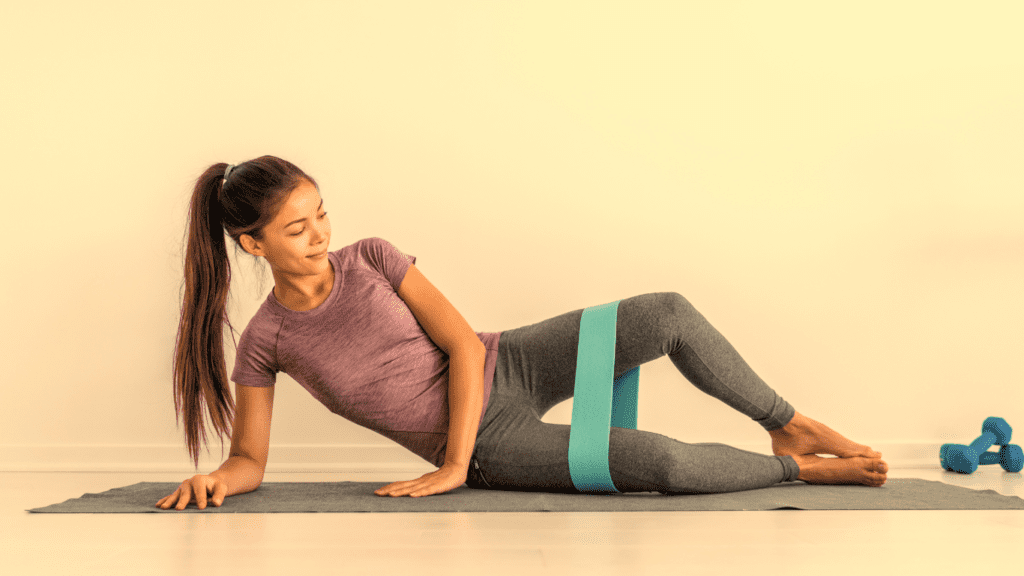
How to Do It:
- Lie on your side with your knees bent at a 90-degree angle and feet stacked on top of each other.
- Keep your feet together and lift your top knee as high as you can without rotating your hips.
- Lower your knee back down to the starting position.
- Perform 10-15 reps on each side for 2-3 sets.
Benefits: Strengthening the gluteus medius improves hip stability and can reduce the risk of lower back pain by ensuring proper pelvic alignment.
3. Squats
Squats are a full-body exercise that effectively engages the glutes while also promoting overall strength and stability.

How to Do It:
- Stand with your feet shoulder-width apart and toes slightly pointed outward.
- Bend at your knees and hips, lowering your body as if you were sitting back into a chair.
- Keep your chest up and knees aligned with your toes.
- Push through your heels to return to standing.
- Complete 10-15 reps for 2-3 sets.
Benefits: Squats strengthen not only the glutes but also the thighs and core, promoting better posture and spinal alignment.
Progression
To build a balanced approach to back health, it is important to incorporate these strengthening exercises alongside your glute stretches for lower back pain. Aim to perform these exercises 2-3 times per week, allowing at least a day of rest in between sessions to give your muscles time to recover.
You can also progress the exercises by increasing the number of repetitions, adding resistance (such as resistance bands or weights), or trying more advanced variations. This will not only keep your routine engaging but also challenge your muscles to adapt and grow stronger over time.
Creating a Balanced Routine
Incorporating both stretching and strengthening into your routine will provide a comprehensive approach to managing and preventing lower back pain. For optimal results, consider the following tips:
- Warm-Up Before Strength Training: Always start with a brief warm-up to prepare your muscles for exercise. This can include light cardio and dynamic stretches.
- Follow with Stretching: After your strengthening session, include your glute stretches for lower back pain to help relax the muscles you’ve just worked. This practice will improve flexibility and prevent tightness from building up.
- Listen to Your Body: Pay attention to how your body responds to both stretching and strengthening. If you feel pain or discomfort, modify the exercises or consult a professional.
- Stay Consistent: Regular practice is key. Aim to integrate these exercises into your weekly routine, setting aside specific times to focus on both stretching and strengthening your glutes.
Strengthening your glutes is a critical component of maintaining long-term lower back health. By combining effective glute stretches for lower back pain with targeted strengthening exercises, you’ll not only alleviate current discomfort but also build a resilient foundation to prevent future pain. Focus on consistency and proper technique, and you’ll be on your way to achieving a stronger, healthier back.
Embracing Glute Stretches for Lower Back Pain Relief
In our exploration of glute stretches for lower back pain, we have uncovered a comprehensive approach that integrates both stretching and strengthening to effectively manage and prevent discomfort in the lower back. To summarize, let’s highlight the key points from this article and understand their significance in our journey towards improved back health.
- Understanding the Connection: We discussed how tight or weak gluteal muscles can contribute to lower back pain. By understanding the anatomy of the glutes and their role in stabilizing the pelvis and spine, we set the stage for effective treatment.
- Scientific Insight: Research has shown a clear link between weak glutes and lower back pain, emphasizing the need for targeted exercises and stretches. This foundation supports our argument for integrating glute stretches for lower back pain into our routines.
- Importance of Stretching: Stretching the glutes improves flexibility, enhances hip mobility, and reduces muscle tension. By incorporating stretches into your regimen, you allow for greater movement freedom and decreased lower back strain.
- Strengthening for Longevity: While stretching provides immediate relief, strengthening the glutes ensures long-term health. Strong glutes support proper posture and alignment, helping to prevent future injuries and discomfort.
- Practical Exercises: We introduced a variety of effective stretches and strengthening exercises tailored to target the glutes. Each exercise was explained with step-by-step instructions and scientific rationale, making it easier for readers to incorporate them into their daily routines.
- Avoiding Common Mistakes: By recognizing common pitfalls such as overstretching, poor posture, and holding your breath, you can maximize the effectiveness of your stretches while minimizing the risk of injury.
- Frequency and Consistency: We recommended stretching 3-5 times a week and highlighted the importance of incorporating both stretching and strengthening into a balanced fitness routine. Consistency is key to achieving lasting results and reducing lower back pain.
Integrating glute stretches for lower back pain into your daily routine requires commitment, but the benefits are well worth the effort. Establishing a consistent practice not only enhances your flexibility and strength but also contributes to overall well-being. Make stretching and strengthening a part of your daily life, and remember that even small, regular efforts can lead to significant improvements over time.
Don’t wait for discomfort to push you into action. Start stretching today to unlock your hips, relieve your lower back, and regain control of your movement. The journey to a healthier back begins with you, and each stretch you incorporate is a step toward pain relief and a more active lifestyle. With commitment and the right exercises, you can conquer lower back pain and enjoy the freedom of movement that comes with strong, flexible glutes.
As you move forward, keep in mind that every effort you put into your health today pays dividends in the future. So grab your yoga mat, set aside a few minutes each day, and start feeling the relief you deserve. Your back will thank you!


